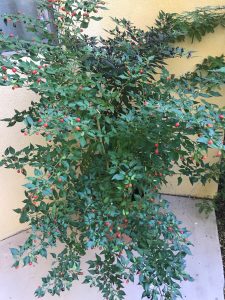Many years ago, I purchased a chiltepín plant from a local nursery. Somehow, through generalized gardening incompetence, I managed to kill the poor thing. Once I admitted to myself that it was dead and gone, I pulled the plant corpse up by the roots, added a bit more soil to the pot, and planted a decorative Jerusalem sage.
Years passed, and I successfully kept the Jerusalem sage alive. One day, while watering the sage, I noticed a small sprout in the soil of the sage pot. It was clearly not another sage. Curious to find out what it was, I decided to let the sprout grow. The sprout grew and grew, until it eventually competed with the sage for space. Flowers formed, and small purple berries grew in place of the flowers. Eventually, the purple berries turned red, and I had a lightbulb moment: somehow, a chiltepin seed from the plant I had slain years ago had remained viable in the soil. The descendent of the chiltepin was now taking over the pot, and my gardening plans. That’s poetic justice for you!
Lessons Learned
- Our gardens are never fully under our control: See a volunteer plant? Let things go a bit wild and wait before weeding it – you might be pleasantly surprised! For additional ways to “go wild” in your garden, check out the following book: The Humane Gardener by Nancy Lawson.
- Surprised by Seed Viability: Typically, pepper seeds maintain optimum viability for 3 years – when they are stored in a cool, dry location. Yet somehow, a chiltepin seed survived for 6+ years while going through extreme swings in temperature and moisture. Nature is amazing!
How to Use Chiltepin
These peppers are tiny and very hot, so you won’t be using them to make chile rellenos. However, they do add great flavor and heat. My husband recently used chiltepin along with a ham bone to season a large pot of pinto beans. Just a few peppers go a long way! The resulting beans were delicious—they did prompt my mother to sigh and admit that my husband’s beans were better than hers.
Saving Seeds
Allow the chiltepin peppers to ripen on the plant – they will change from purple to red as they ripen. Once the peppers start to wrinkle and the stem turns brown, they are ready to harvest for seed saving. Dry them in a paper bag for several weeks before processing. I recklessly used my fingernails to pry the dried peppers apart. If you choose to risk using your bare hands, DO NOT touch your face, and certainly not your eyes. Scrub your hands well when finished, or try soaking your hands in milk to deactivate the capsaicin. A safer route, but with less dexterity: use gloves! (Especially recommended if you have sensitive skin).
Wishing you all plenty of serendipitous volunteer plants!
Contributed by Amy of Oro Valley Public Library.




